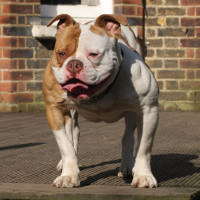Appearance of the American French Bulldog
|
| Stocky comes to mind when describing the American French Bulldog. The body is muscular and solid, neither fat nor flabby. They have a more athletic shape than their parent breed, and are shorter than the American Bulldog but taller than the French Bulldog, coming somewhere in the middle. These dogs are medium-sized, smooth-coated dogs with low-slung bodies and large heads. The shoulders are normally broad and they have robust limbs. The general appearance suggests strength, stability and vigor. American French Bulldogs are gentle, resolute and courageous, but not vicious or aggressive. They have round, dark eyes that are set wide apart, as are their bat-like ears. Their tails are long and whip-like. They resemble a working dog, but can integrate very well into family life. |
Temperament of the American French Bulldog
|
| This hybrid breed shows intense loyalty and devotion to its family, and would give its life without hesitation. These dogs love being with their families, which can lead to separation anxiety. Surprisingly, these dogs are true cuddlers with their loved ones and can be incredibly gentle and caring. When properly socialized, the American French Bulldog is trustworthy around young children, but because of its solid build, it can sometimes be a little rough, unaware that it can accidentally hurt a little person during a noisy playtime. This breed needs a strong leader, or they can become stubborn and even snappy. They must have consistent rules. They can be difficult to train, requiring a lot of perseverance and patience. The American French Bulldog is an energetic breed that loves to go for walks or play games. They are very protective of their homes and make good watchdogs. |
Needs and activities of the American French Bulldog
|
| The American French Bulldog enjoys a daily walk, and this will keep your dog fit and healthy. Younger dogs like to jog alongside your bike, while older dogs are better off with a walk. This hybrid dog needs plenty of mental stimulation, otherwise he can get bored and get into trouble. It's an active dog and can therefore be difficult in an apartment, unless well exercised. These dogs are dogs and like to be with their family; they don't like to be forbidden outside in a kennel, as this can cause anxiety. A house with a well-fenced yard works best for this breed, whether in the city or in a rural setting, it will suit them perfectly. They prefer a medium-temperature climate; extreme heat or cold can cause distress. |
Maintenance of the American French Bulldog
|
| The American French Bulldog has a short, dense coat that requires minimal maintenance. Although considered moderate shedding, weekly brushing with a firm bristle brush helps to minimize this problem. He's a clean dog, needing a bath only when he's rolled in mud or something stinky. While brushing, it's a good time to take a quick look at your dog's health. This observation involves looking to see if there are any skin complaints, cuts or bumps that may need attention. If you live in an area where fleas and ticks live, you can take this grooming time to make sure none have settled into your dog's fur to live. The American French Bulldog is very easy to care for, which makes it attractive to families. Nails, eyes, teeth and ears are the main things to check, making sure they're all in good health. Teaching your young dog to accept you brushing his teeth will help you later in life. |









 English (United Kingdom)
English (United Kingdom)